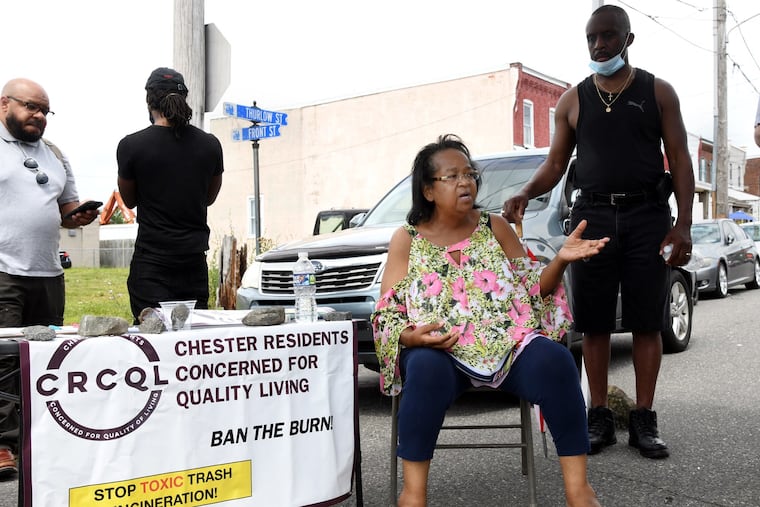‘Waste-to-energy’ is a bad deal for Chester and other polluted communities | Opinion
Burning trash is so out of synch with modern, widely agreed-upon environmental goals and waste management techniques that it’s hard to believe anywhere still allows it.

The term “waste-to-energy” has long sounded like nonsense to people in Chester, similar to many communities I’ve worked with across the country. As The Inquirer recently reported, Chester residents knew almost 30 years ago what we all know today: Trash incineration is dirty, dangerous, and discriminatory. The small amount of energy it produces does not make up for the damage it causes to the environment, to our own lungs, and, in particular, to neighborhoods struggling for equity.
The people of Chester — a working-class city that is about 70% Black and 12% Latino — have been living in the noxious shadow of Covanta’s Delaware Valley Resource Recovery Facility since 1992. It is the largest trash incinerator in Pennsylvania, and possibly the largest in the country, making Chester a grim leader in a nation that is dangerously stuck in the past on waste management.
» READ MORE: For 30 years, she has fought a waste-to-energy plant in Chester City: ‘We don’t have a choice’
While concerned — and sometimes sick — Chester residents were told that they didn’t know what they were talking about, the plant’s smokestack was emitting heavy metals, dioxins, lead, mercury, nitrogen oxides, and particulate matter — pollutants linked to health problems including asthma, heart disease, and more. Long-term exposure to particulate matter has also been shown to increase the risk of death from COVID-19.
Burning trash is so backward and out of synch with modern, widely agreed-upon environmental goals and waste management techniques that it’s hard to believe any state or municipality is still allowing it. And yet some, including the state of Pennsylvania, have subsidized this archaic industry as an energy source — choosing to stay in the polluting, unjust past instead of moving toward an environmentally and economically healthy economy and clean energy future.
In Europe, officials are well aware that burning trash emits nearly twice as much carbon as the EU grid average. They are urging member nations to minimize incineration in order to both mitigate climate change and move toward a circular economy. The EU is cutting off funding for new incinerators, and officials have excluded the trash-burning industry from a new set of green guidelines for sustainable finance, pushing Europeans toward circular waste and energy solutions that minimize waste to start with and convert waste to valuable products.
The U.S. has opportunities to set similar precedents and change the direction of the waste management and energy economies. For example, Congress is working on language to define a “clean electricity standard” — a new definition that should exclude the burning of trash. The reconciliation bill that may determine infrastructure spending is another opportunity to fund modern, clean, circular infrastructure solutions instead of the dangerously outdated incineration industry.
» READ MORE: Covanta to pay $218K for past pollution emissions at Conshohocken waste-to-energy plant
To move our country forward, lawmakers will have to see through misconceptions such as, “If we don’t incinerate, the waste will go to an even-more-polluting landfill.” That type of reasoning ignores the options of reuse, recycling, and true clean energy production, and is often used to silence local advocates.
When those who burn trash try to argue that particulate matter doesn’t matter, leaders should consider that any particulate matter in the air exacerbates the already disproportionate amount of pollution and disease in largely neighborhoods of color.
This ongoing injustice can be solved with circularity. Reuse and recycling are worth the investment to convert waste into valuable products and reduce greenhouse gas emissions.
It’s time to listen to the sense of the people in communities like Chester, who know that burning trash not only degrades their air and makes them sick, it leads to a cycle of further noxious land uses and lost economic opportunities — in effect, environmental redlining.
We have the opportunity to convert the mistakes of the past to a vibrant, clean future for Chester and other communities through an economy that delivers true clean energy, restores clean air, lowers energy costs, and benefits residents through job creation.
If their pleas are ignored, the U.S. will be left behind in the global clean energy revolution, and environmental justice communities with the most to lose will continue to get sick and be left behind.
Mathy Stanislaus served as the U.S. EPA assistant administrator for the Office of Land and Emergency Management during the Obama administration. He is the director of public policy and engagement for the Global Battery Alliance, a public-private alliance of governments, civil society groups, and companies seeking to help establish a sustainable battery value chain.